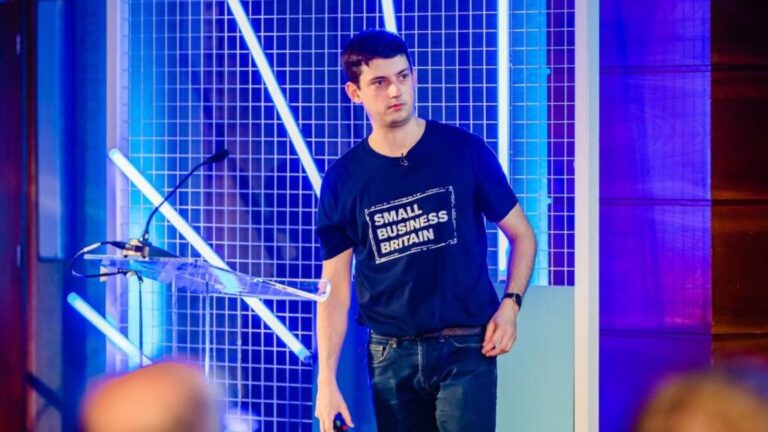
In 2020, 22% of the UK’s economy was made up of small businesses – more than 5 million of them – and companies with fewer than 49 employees generated around 52% of the country’s total revenue. When it comes to carbon reduction, smaller businesses can have a major impact, but existing guidance is predominantly focussed around large multinationals and smaller businesses are overlooked.
Small99 is an organisation created to make carbon reduction guidance accessible to these hugely influential smaller businesses. Founder Adam Bastock had been working with small businesses for 8 years, growing them through practical digital marketing guidance.
Noticing that, like digital marketing, talk of Net Zero and Climate Action was getting caught up in technical terms and, as a result, terrifying business owners, he set out to empower them with clear, actionable guidance.
With an ambition to guide 1 million small businesses to Net Zero by 2025, since founding Small99 in 2020, he has engaged over 50,000 businesses on taking small steps for big impact towards carbon reduction.
Here, Adam considers the challenges around sustainability facing small businesses, and highlights the opportunity presented by changes in supply chain requirements A few years ago, sustainability was all of the rage. COP26, hosted in Glasgow in 2021, feels like a lifetime ago, and while climate change is still in the news, the economic turmoil over the past few years has taken the focus for small businesses.
Environmental action and carbon emission reduction have been sidelined by short term survival.
Given the economic situation, small business owners may be forgiven for thinking net zero and sustainability progress has ground to a halt.
However the reality is quite the opposite. Progress has moved from attention-grabbing headlines, to the eco-rubber quietly hitting the road in a more pragmatic way. Away from the buzzing conference halls and panel sessions, we’re starting to see a quiet evolution happening. No longer confined to a theoretical future, we are seeing the supply chain become the place of real pressure and progress. For your business, this is both a threat and an opportunity.
A shift of focus
Before we get into why this is happening, it’s important to take a step back and understand the wider context and how we got here. Put your seatbelt on, as we’re heading into a bumpy road full of jargon. A few things have happened since 2021, and a rapidly shifting landscape has made it hard to keep up with unless you are particularly keen on environmental policy updates like I am (I am fun at parties, honest).
Firstly, we’ve seen a big shift away from the term “carbon neutral”.
While it’s a relatively straightforward and established concept – you measure your footprint and get a figure in tonnes, then you purchase offsets equal to your carbon footprint to “neutralise” it, and the scales arebalanced – it has quickly fallen out of favour in the industry.
Offsets themselves, generally in the form of paying for carbon removing activity somewhere in the world like tree planting, have come in for heavy criticism. Not least because, in some studies, 90% or more of offset credits have been regarded as ineffective, or to simply not exist.
Trees also take a long time to grow, so paying to plant 1 tree now doesn’t really mean much if it takes 20 years to start drawing down carbon. And what if that tree burns down in a wildfire due to the impacts of climate change? (We should say, tree planting and nature restoration is vital and important work, but needs to be paired with wider action and not simply “scale balancing”).
More broadly, this carbon neutrality and offsetting becomes very messy very quickly, with large industry organisations like the Science Based Targets Initiative (SBTi) getting into increasingly hot water with their decisions to allow corporations to increase their use of it. Some in the industry see it as the “trading of indulgences”, allowing businesses to continue highly polluting activity so long as they buy some carbon credits.
In short, it gets confusing to know what to do as a small business. I would hazard a guess you are more focused on your customers than theories over tree planting and carbon sequestration strategy.
At this point, you may be thinking “What does this mean for me?”. The shift in language is important to understand, as it’s all contributed to the increasing popularity of a much newer term: Net Zero.
Action focussed
Net Zero, unlike Carbon Neutral, requires action. The SBTi requires a 90% reduction in your emissions against a baseline year as your target, and a 50% reduction by 2030 (which is now only 5 years away, by the way).
For example, you measure your emissions from 2019 to be 100 tonnes of carbon emissions equivalent – so including methane, nitrous oxide, carbon dioxide and fluorinated gases. If you have a Net Zero target of 2050, this would mean reducing your footprint to 50 tonnes by 2030, and down to just 10 tonnes by 2050. Net Zero is gaining much more traction thanks to this action-oriented approach and is where the knock-on effects on business start to emerge.
If that feels a bit overwhelming, the good news is that you’ve likely already made progress on Net Zero without even realising it. Take electricity for example, which has been a great success story in terms of reducing emissions. In 2012, around 45% of electricity came from burning coal. By 2023, 40% of our electricity came from wind and solar. This remarkable change, in just over a decade, has seen 1kWh of electricity drop from generating 500g of CO2e in 2012, to 189g of CO2e in 2019 with the figure projected to be as low as 122g by the end of 2024 (all figures from https://grid.iamkate.com/).
Currently Net Zero targets are entirely optional for small businesses.
However, this is where we begin to see the supply chain journey I mentioned at the start come in. Large organisations have been required to report on their carbon footprint annually under SECR (Streamlined Energy and Carbon Reporting) since 2019. These are defined as any organisation with more than 250 employees, or a turnover of £36m. Other 4 letter acronyms (which I’ll leave the treat of googling to you to save all of our sanity) include CSRD, TCFD, IFRS, ISSB, TFND and ESOS, all of which impact corporations.
CBAM, the Carbon Border Adjustment Mechanism, is a more interesting and relevant European piece of legislation likely to impact small business. While focused on the EU, the UK is likely to follow in 2026. Under CBAM, materials such as iron, steel, aluminium and hydrogen will be taxed based on the carbon emissions created during their production as they enter the European market.
This is likely to impact on any small business purchasing currently “cheap” goods that may not have the true environmental costs included, and may make locally produced, lower carbon goods more cost effective. If businesses are able to demonstrate their product is lower emissions than imported competitors, CBAM may open up business growth opportunities for them.
Ripples – impacts and opportunities
As corporations start to measure their emissions in more detail, we are seeing a secondary impact occur away from the legislation. Indeed, legislation itself is unlikely to directly affect smaller business, but the ripple effects it is having should not be ignored.
Mostly it is due to the reduction requirements that Net Zero brings. During the excitement of COP26, a flurry of corporates committed to Net Zero targets, perhaps without fully realising the implications. Having now dug deeper into their own emissions, many have discovered that the largest part of their corporate footprint in fact comes from their supply chain, rather than their direct activities.
Usually, 80%+ of a larger organisation’s carbon emissions are related to how it is spending its money with suppliers. As these must be accounted for, all of the large and small businesses that exist in their supply chain are being engaged (pushed or pulled) into that drive to meet their targets, or they may find themselves missing out on contracts.
The NHS has particularly good public information on their carbon reduction plans in this area. Their NHS Supplier Roadmap states that, from April 2027, all suppliers will be required to submit carbon footprint and carbon reduction plans. Microsoft has similar requirements that are hitting all sizes of organisation.
Such pressures are only just starting to come to light as carbon footprinting matures as an industry, and it is likely to be a sore point for corporates for several years, as they seek to remove stubborn suppliers working against their Net Zero commitments, and replacing them with proactive ones who are (even quietly) shouting about their successes around climate and carbon emissions.
Climate action is being pressed forward in supply chains. The economy is made up of millions of decisions every day, and this is where forward thinking businesses can position themselves ahead of the curve and win more customers and clients who are experiencing pressure on carbon footprints. However, it’s vital you actually share your stories with this in mind!
Quiet confidence is the name of the game. In our experience of training and consulting with thousands of small businesses, few are keen to properly shout about their achievements for fear of greenwashing accusations, even when they deserve praise for ambitious, and sometimes weird but wonderful, environmental initiatives.
Carbon emissions typically translate into cash too. For example; the more you are spending on fuel, the more emissions you generate. Therefore, the lower your carbon footprint, the more money you’ll be saving. Net Zero is fundamentally an efficiency drive across all areas of your business. The less paper you throw away, the less someone is spending buying it. The less water used to over-fill kettles, the less money spent on electricity.
That does not mean it will be easy and, as always, any investment in business will have an ROI that may be some years away.
Sustainability is a competitive advantage
Clearly it would be a mistake to dismiss Net Zero as jargon that is a fashionable, short lived trend. It has perhaps stepped back from public discourse but entered into the board rooms and procurement teams concerns, and isn’t going anywhere. Removing carbon is going to be a stubborn but necessary task, and one that provides opportunities for those wishing to move first.
Having a clear story, with realistic targets and a demonstration of what you have done is often all it takes. The barrier, currently, is pretty low for sustainability communication. For example, there are likely things you have already done around low carbon solutions, waste management, energy efficiency and fuel training for drivers. But have you put this into a single page on your website that shares this publicly?
The road ahead may feel daunting with acronyms and technical jargon. But, as a small business, the opportunity is clear: solve your customer’s pain. If you work with a larger business as a client, or are looking to, demonstrating your competence and ambition on sustainability is going to be, and already is, a competitive advantage for you to exploit. This may be in telling your story with confidence, or entirely new product ranges within low carbon heating technology.
Take action, share your story, and win more customers.
Are you keen to get an idea of your footprint and some starting actions? Visit https://measure.small99.co.uk/ or listen to the podcast “Small99: Small business to Net Zero” for ideas and stories from other small businesses.
Image credit:

